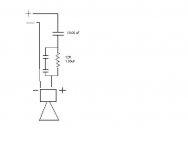I work with some W8LC boxes which consist of:
12" (300mm)/3" (75mm) voice coil,
Hybrid™ bass horn loaded
2 x 6.5" (165mm)/1.5" (38mm) coil drivers,
horn loaded
3 x 1" (25mm) exit HF compression drivers,
horn loaded
They are designed to be used with external active crossovers made by Lake.
My question is this, on the back of the NL8 input panel is a network of capacitors and resistors which are connected to the HF Drivers. Being a novice, I initially assumed that it was a xover network, but these boxes are externally crossed over, and the cap/resistor network is only connected to the HF drivers.
What is this network? What does it do? Does it have something to do with the HF's being compression drivers? Just curious.
12" (300mm)/3" (75mm) voice coil,
Hybrid™ bass horn loaded
2 x 6.5" (165mm)/1.5" (38mm) coil drivers,
horn loaded
3 x 1" (25mm) exit HF compression drivers,
horn loaded
They are designed to be used with external active crossovers made by Lake.
My question is this, on the back of the NL8 input panel is a network of capacitors and resistors which are connected to the HF Drivers. Being a novice, I initially assumed that it was a xover network, but these boxes are externally crossed over, and the cap/resistor network is only connected to the HF drivers.
What is this network? What does it do? Does it have something to do with the HF's being compression drivers? Just curious.
I assume (as I'm not familiar with the design) it is there to protect the high frequency driver against DC/low freqs... And some attenuation?
Picture or (preferably) schematic of this network? It should be pretty easy to tell it's effect from the schematic.
Well, I'd have to know the impedance of the tweeter to tell you more, but that circuit creates a 1st order high pass network (6dB/oct, and the 10uF means it's probably at a fairly low frequency) and then reduces the lower end of the tweeter response (effectively "boosting" the upper end the response by comparison). I don't know at what point it begins the boost, but the 2uF (effective) cap would suggests it starts fairly low (4Khz? Lower?) and the 12ohm resistor provides a fairly significant cut. It probably does this because the tweeter response rolls off at higher frequencies.
Well, if the network applies to all three drivers then you would consider their combined impedance.
- Status
- Not open for further replies.
- Home
- Loudspeakers
- Multi-Way
- Martin Audio W8LC question
